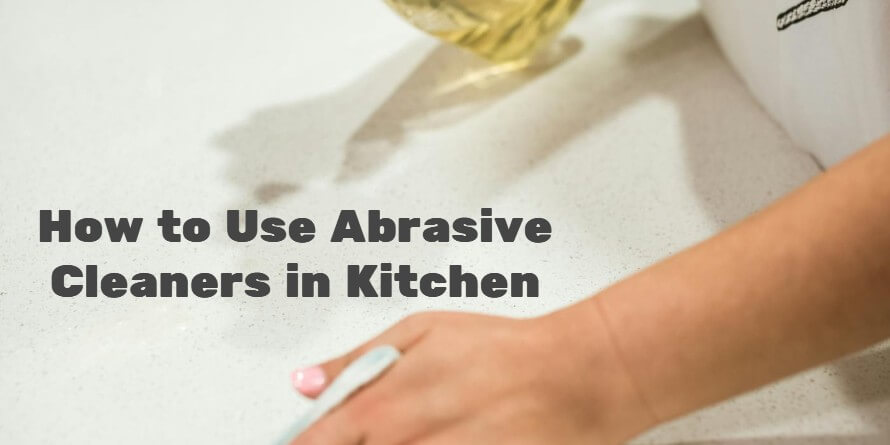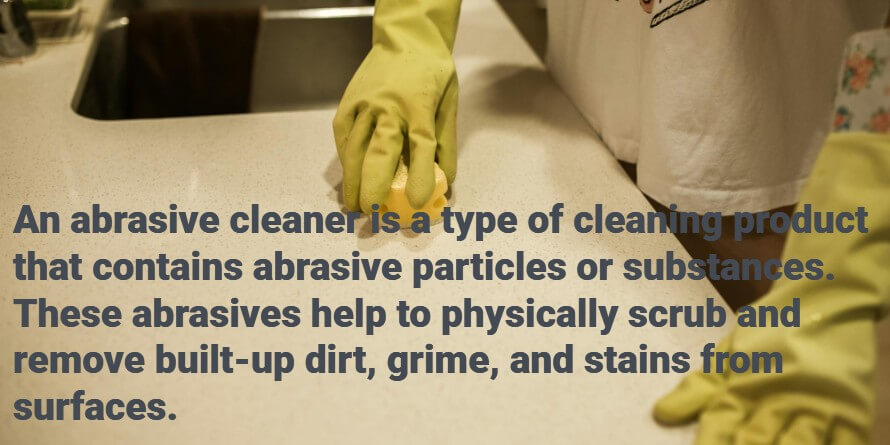Abrasive cleaning agents are highly effective cleaning substances or materials that remove debris like dirt and stains from plastic, metal, ceramics, and other surfaces. Their chemical properties and abrasive cleaners cause friction which slight friction with a physical scrubber is key to removing debris that sticks firmly to the surface.
How to use abrasive cleaner in kitchen? You can buy them in liquid or powder form, depending on your preference and convenience. In this article, we will talk about the 10 examples of abrasive cleaners.
The cleaning agents are primarily divided into physical, mineral, and chemical abrasives. Abrasives are highly important to maintain the cleanliness and hygiene of a kitchen.
Along with effective and efficient cleaning, most abrasive cleaning products also have sanitation properties that kill the existing germs in the kitchen and break their life cycle, preventing further germination.
What is an Abrasive Cleaner? Abrasive cleaners are used to reduce mess and dirt that you can’t remove with the gentle cleaning methods. You can use the liquid or powder from this ingredient, such as Copper, Nylon, Steel wool, metal, oxalic acid, and mineral particles.
How to Use Abrasive Cleaner on Kitchen Stains and Cabinets
Over time, rust destroys the actual appearance of the kitchen, but abrasive cleaners restore the actual and fresh appearance of the surfaces, making them new again.
Abrasive cleaners cause friction, which loosens dirt from the surfaces. It creates friction to remove dirt and stains from the floor surface.
Let’s explore how to use abrasive cleaners in kitchen stains, and abrasive cleaners cause friction which is the main reason.

Types of Abrasive Cleaning Agents
Abrasive cleaner agents are divided into the following categories based on their material and friction capacity. Users can use these types of abrasive cleaning products according to the cleaning surface type, material, and stain or dirt situation.
Physical Abrasive Scrubbers:
This type is available in the market in a variety of grades. The user can buy a coarse scrubber to deal with stubborn stains or a fine scrubber to clean smooth and less dirty surfaces. This type of cleaning scrubber is ideal for general cleaning, usually delicate surfaces.
Mineral Abrasives:
When we search “How to use abrasive cleaner in kitchen cabinets”, the mineral abrasive is the most accurate answer. As the name suggests, these are minerals in their natural forms or processed forms, including baking soda, borax, and salt.
They not only clean but also ensure the deodorizing and disinfecting of surfaces against germs.
Chemical Abrasives:
Chemical cleaning comes in two forms: powder and liquid, and both are synthetic. They usually contain a mixture of abrasive particles and chemicals, so they are comparatively very effective and ideal for heavy-duty cleaning.
Commercial Abrasive Cleaning Products:
They are sold at the commercial level and are usually used in high-traffic kitchens like hotel kitchens and mess kitchens. Therefore, they are formulated to handle more heavy-duty cleaning than chemical abrasives.
They are also ideal for multi-surface cleaning and can’t be used without wearing gloves.

5 Examples of Abrasive Cleaners
Here are the top examples of abrasive cleaners in the kitchen that clean naturally and effectively without causing harm to the surfaces. You can also get these abrasive cleaning solutions from top-rated abrasive cleaner brands.
1. Baking soda abrasive cleaner
It’s a natural abrasive cleaner that is nontoxic and gently cleans without tarnishing the beauty of the surface. It also offers deodorizing. It can be used to clean sinks, ovens, and counterpots. Most importantly, it’s inexpensive and environmentally friendly.
2. Steel Wool Pads
They can be used in various grades and ideally clean tough stains, grime, and burnt-on food from posts. However, they can scratch delicate surfaces, so it is advised to use them on softer, delicate materials.
3. Comet Cleanser
It is a mixture of calcium carbonate and bleach, which are quite strong and mostly used to clean toilets, but also for a bit of dirty sinks and bathtubs. This cleaner usually comes in powder form and disinfects the surface, along with cleaning it, but it can’t be used without wearing gloves.
4. Nylon-Coated Sponges
These are ideal for delicate surfaces, nonstick cookware, and glass because they provide mild friction. Their specialty can be defined as “Gentle yet effective,” which conveniently removes the light strains without causing any harm to the crockery surface.
5. Pumice Stone
Tough stains from hard surfaces, like toilet grills, and rust from metal surfaces are the ideal cleaning tasks for pumice stones.
So, it is crucial to test them on a small area before applying them in the required place. Don’t use them without wearing gloves; avoid using them on delicate surfaces.
Besides these 5, 10 examples of abrasive cleaners are the following, which are less known but effective:
There are a number of abrasive cleaners, which is, more than 10 example of abrasive cleaners. Let’s have a look!
- Plastic scrubbers
- Steel brushes
- Scouring powders (e.g., Comet)
- Sandpaper
- Metal mesh balls
- Coarse pumice
- Fine brass wool
- Rotten-stone
- Fine plastic mesh pads
- Whiting
When to Use Abrasive Cleaners?
To use abrasive detergents for the kitchen effectively, knowing when and how to use them is crucial. Usually, when your kitchen counterparts get coffee stains and food piles, they look very bad and destroy the overall beauty of your kitchen.
Similarly, over time, sink basins accumulate soap scum and water spots, and kitchen tiles may get grout. In all these vases, it is ideal to clean them with abrasive cleaners. This is an abrasive cleaner definition.

Besides these, you may need to clean:
- Burnt-on food residue in oven interiors in backed-on spills, cookware including pans and pots, and stovetops when they get food spills.
- Grease and oil buildup over kitchen surfaces, from filters, behind the stove, and cabinet doors, especially near the cooking areas.
- Limescale and mineral deposits are caused by the use of hard water in faucets and fixtures, dishwashers, and glassware.
How to Use Abrasive Cleaners Safely and Effectively?
To use abrasive cleaners effectively, first, you must identify suitable surfaces so that tose can easily bear their scrubbing action. Such surfaces may include stainless steel, ceramics, glass, and porcelain.
Now, to use them safely, carefully follow the given steps:
- Dampen the surface because it will help the abrasive cleaners to spread easily and widely.
Apply cleaner through a light sprinkling, or if the surface is dirtier, apply it directly. - Scrub gently using a soft sponge in a circular motion, but to avoid scratches, avoid applying heavy pressure.
- Rinse thoroughly and check if there is any residue left.
- Dry the surface if no residue is left and wipe it out with a dry and neat cloth. This will help prevent water spots from occurring again.
FAQs
What are Abrasives Used for in a Commercial Kitchen?
They are used to clean pots, pans, floors, and equipment and to remove rust and tarnish.
Should You Use an Abrasive When Cleaning a House?
Yes, but only if it suits the respective surface’s material, doesn’t cause scratches, and effectively removes the hard stains.
What are the Different Types of Abrasive Cleaners?
There are three major types: physical abrasive scrubbers, mineral abrasives, and chemical abrasives.
What is the Use of Abrasives in the Kitchen?
They remove the stubborn dirt, stains, grime, food burnt-on, residue particles, grease pileups, oil buildups, limescale, and mineral deposits.
What are Examples of Abrasives in the Kitchen?
Some common examples are steel wool pads, plastic scrubbers, nylon-coated sponges, baking soda, and chemical abrasives.
The Bottom Line
Cleaning agents in the kitchen are genuinely effective ways to clean and make it look lush and new. Choose the cleaner type and scrubber wisely from the abrasive cleaners example mentioned above.
keeping every necessary factor in mind, and avoiding using heavy-duty scrubbers for delicate surfaces to avoid scratches and damage.
You should also remember that wearing gloves, having good ventilation to avoid inhaling fumes, taking a precautionary patch test, and avoiding mixing cleaners with other cleaning agents are crucial for your safety.
I think now you have a solution for how to use abrasive cleaner in the kitchen.

